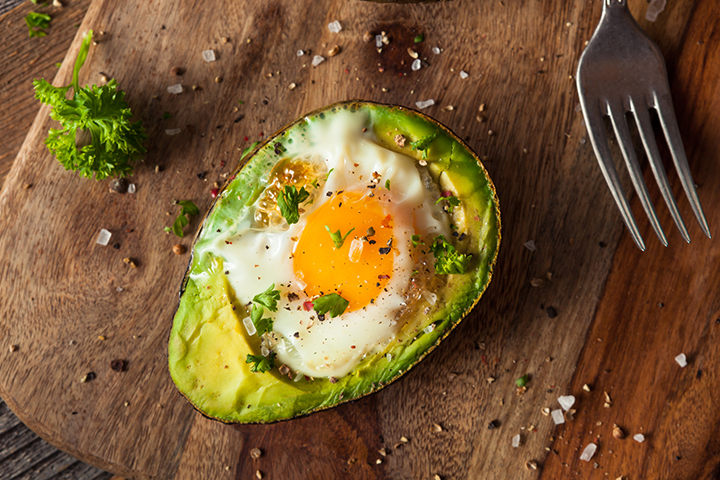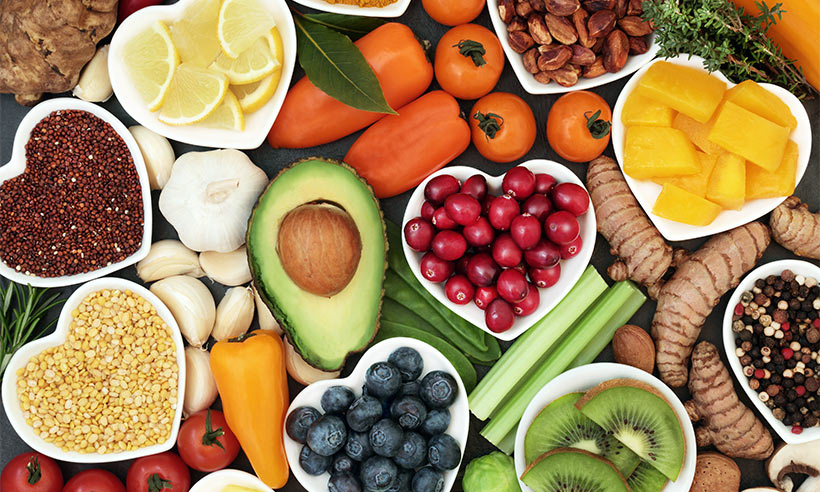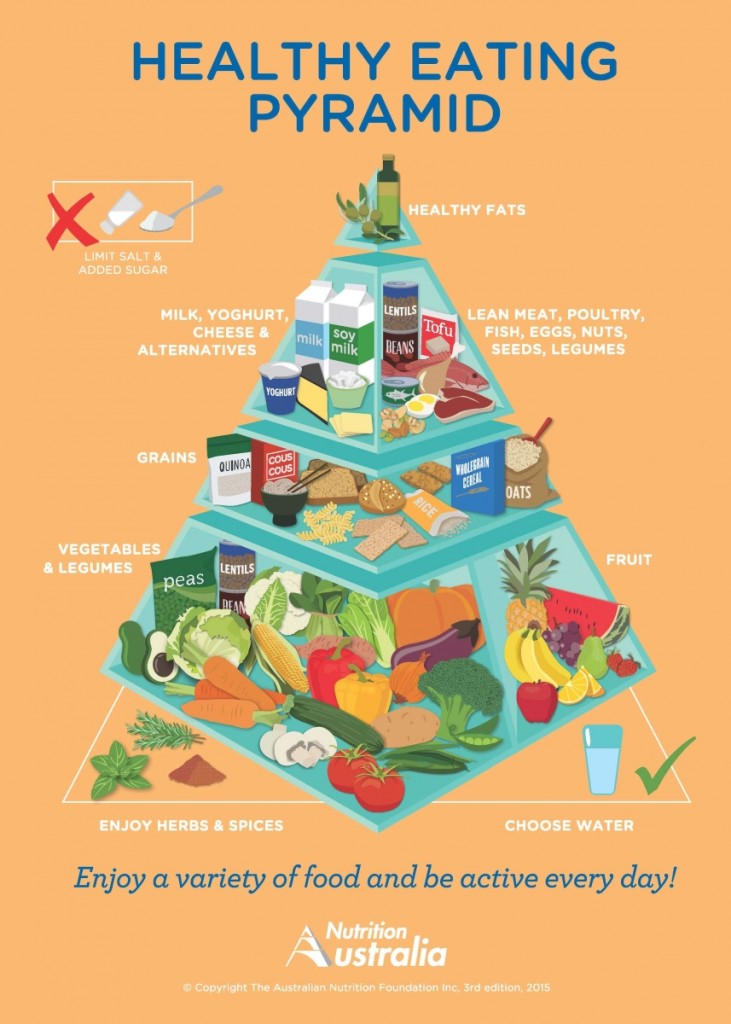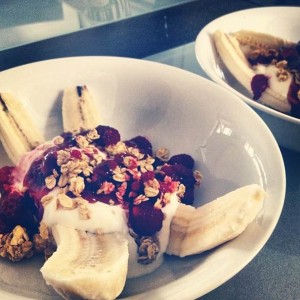
Start your day with an easy to prepare ‘protein and produce’ type breakfast, packed full of nutrients, and sugar free!
Ingredients:
- 6 avocados halved and seeded
- 6 large eggs
- salt and pepper, to taste
- 2 tablespoons chopped chives
Method:
- Preheat oven to 425 degrees F. Lightly oil a baking sheet or coat with nonstick spray.
- Using a spoon, scoop out about two tablespoons of avocado flesh, or more, as needed, creating a small well in the center of each avocado.
- Gently crack 1 egg, and slide it into the well, keeping the yolk intact. Repeat with remaining eggs; season with salt and pepper, to taste.
- Place into oven and bake until the egg whites have set but the yolks are still runny, about 15-18 minutes.
- Serve immediately, garnished with chives, if desired.
From https://damndelicious.net/2016/10/05/baked-eggs-in-avocado/

‘Veganism’. A word which is the catalyst for many debates and let’s face it, some pretty hilarious memes. However, as you have probably all noticed, the vegan lifestyle is becoming more and more popular and there seems to be an increased awareness across the board. Hopefully what follows will give you a brief insight into my life as a vegan and the effect it’s had on me, physically and mentally.
My Transition
I became vegan on the 11th of August, 2015, and I have to say it all happened pretty organically. My partner had been a vegetarian for approximately two years so my consumption of animal products had naturally reduced over that duration – but meat, eggs and dairy still made up a fair bit of my diet. She asked if I would be interested in watching a documentary called ‘Earthlings’ which looking back, was probably what started the transitioning process. I’m not going to go into the discussion of ethics – we’ve all seen the videos and anyone with an ounce of compassion can appreciate the moral justification behind veganism. Instead, I’d more like to focus on the health benefits of a plant-based diet, as this was a huge driving factor with me wanting to becoming one of those crazy extreme vegans. After viewing the documentary, I immediately dove into researching the health benefits of a vegan diet and that was “all she wrote”.
Current Diet
Now fast-forward almost 3 years and I couldn’t be happier. Now, I don’t want this article to turn into a solo episode of “This Is Your Life”, because to be honest I could talk about this stuff all day. Instead, I’ll choose three of the more significant diet-related points regarding my experience thus far with veganism.
- Micronutrients – the bottom line is that plant-based diets, when done correctly, will always result in eating a larger variety of foods. More experimentation takes part in the kitchen, more enjoyment is had with cooking, and as well as being very tasty, the meals are more colourful – and more colour means more nutrients! For example, when you’re meeting your protein requirements with foods such as beans, legumes, grains, nuts, seeds and vegetables rather than beef, chicken or fish, it’s pretty safe to say that you’re meeting many other nutrient requirements as well. Long-term, this sets you up for a far healthier and problem-free life, as you reduce your risk of chronic disease. For example, 28% of deaths in the year 2016 in Australia were a result of heart disease. A very significant factor of heart disease is atherosclerosis – the thickening and hardening of vessel walls – and a major cause of this is high cholesterol. But how many people know that dietary cholesterol solely comes from animal products, and that your liver produces enough cholesterol alone for normal bodily function? For me, the proof was in the pudding when, out of curiosity, I had a blood test in February of this year. My results were perfect, and my doctor was pretty impressed. Also, another fantastic change is that I haven’t been sick since becoming vegan, at all.
- ‘Feeling healthier’ – I have a very clear memory of 2014. I was in a ‘bulking’ phase and was consuming around 4000 calories each day. I have always strived to be the healthiest I can be, so even during this phase I was still eating plenty of vegetables and wholefoods. However, I still felt so crap. Every meal was a bigger struggle than leg day, and I was pretty lethargic the entire day. It was hard! Fast-forward to now and eating that same number of calories is entirely different. There is a noticeable difference with bloating and lethargy, and I’m generally more energetic. It’s hard to explain, but I honestly just feel healthier.
- Travelling and eating out – this is something a lot of vegan’s struggle with, but I’ve never really had a problem. Since being vegan, I’ve travelled to over 20 countries with my partner and we’ve never had an issue (thanks to wonderful apps such as HappyCow). Also, almost every restaurant has vegetarian options, and it’s never a difficult task to make these choices vegan-friendly – such as swapping out an egg or dairy product for a suitable alternative. What upsets me is hearing of complaints from the vegan community about restaurants NOT having enough vegan options. At the end of the day, veganism is in it’s infancy, and recognition on a menu in the form of a meal labelled as “Vegan” or “Vg” is a total win in my books. Recognition = awareness, and that’s the beautiful thing.
Current Training and Physical Changes
Training progress, body composition and my style of exercise have also all changed quite considerably. In addition to continuing compound strength training, I now incorporate a lot more gymnastics movements and bodyweight training into my regime and am thoroughly enjoying it. All of my personal bests for bench press, deadlifts and barbell squats have improved considerably, and I have learnt new skills such as handstands and ring muscle-ups. Could I have still achieved this as a meat eater? Probably. But, nothing feels better than going to the gym full of energy (which I didn’t always experience as a meat eater) and feeling like you can conquer anything. Also, it feels great to somewhat prove people wrong. Vegans cop a lot of flak and are always being targeted as ‘protein deficient’ or ‘malnourished’, but I’ve experienced more strength and muscle gain than ever before.
I would like to point out that I am not an expert on veganism and don’t claim to be. As I said, I strive to be well-educated and due to this point, my knowledge on diet and training is forever expanding. Also, my journey with veganism and the positive results I have experienced are just that – mine. Any diet can be done incorrectly, and individuals need to be well-educated with whatever it is they choose to consume.
Thanks so much for reading,
Matt
For information on training with Matt, contact us info@js-pt.com.au or PM us through our socials (Facebook, Instagram). For great content including vegan recipes and training videos, Matt can also be found on Facebook and Instagram.

Making sense of what exactly is good and bad nutrition is a tough gig for most people. You could bet your bottom dollar that for every piece of information you find on what you should do, there will be a counter argument somewhere as to why you shouldn’t do it. Thankfully, Nutrition Australia finally released it’s new and revised food pyramid last month which aims to clear things up. Let’s take a closer look:
1. Vegetables take centre stage
The bottom layer of the food pyramid is now predominantly vegetables as well as legumes and fruit. With the high amounts of vitamins and minerals present in these foods, they have been linked to a reduced risk of a number of serious diseases such as cancer, heart disease, and type 2 diabetes.. Vegetables and fruit are also high in fibre which helps with weight control. Given an estimated (and shocking) 7% of Australians reach the recommended daily intake of vegetables, this is a good start to the new pyramid.
On a side note, while both are good options, still aim to eat more vegetables than fruit.
2. Include healthy grains
The renamed carbohydrates group has shifted up from the bottom of the pyramid to put more emphasis on Australians eating more vegetables. Carbohydrates, even with their bad reputation these days, are essential in a healthy diet and the new pyramid encourages (whole)grains such as quinoa, brown rice, multigrain breads, and oats which are also all rich in fibre. That being said, other carbohydrate options such as white rice are not poor options and can easily be included in a well balanced diet.
3. Have a mix of different sources of protein
The second top layer emphasises consuming a variety of protein sources from dairy, meat, and non meat products. While red and white meats are the obvious choices of protein, people often forget dairy products (such as cottage cheese and greek yoghurt; whey protein powder also falls in this category) are also rich in protein as well as being high in calcium.
Consuming a mixture of fish, nuts, and seeds will not only give you variety in your protein, but will also help you reach your recommended intake of healthy fats.
4. Fat is good
Fats are often neglected but they have major roles in the body which include manufacturing and balancing hormones and improving brain and nervous system health. A mix of monounsaturated and polyunsaturated fats are ideal for optimal health. They can be found in oils, avocados, nuts and seeds, fish, and eggs.
5. Junk food has been canned
The previous food pyramids had junk food at the top in the ‘eat in small amounts’ category, and whilst I think the amended food pyramid is much better, I will say that eating a small percentage (under 10% of your daily intake) on whatever you wish will not have an effect on your overall body composition and will also help you control cravings. For the average person though, not having the junk food option on the pyramid is the correct stance.
All in all, Nutrition Australia has done well with the updated version of the food pyramid. For the average person, it is a good starting point to refer to and if followed consistently would definitely improve the current eating habits of Australians unfamiliar with good nutrition practices. Putting more emphasis on vegetable intake is a much needed addition to the pyramid, and is definitely one aspect of nutrition which is hard to disagree on, regardless of what your good and bad nutrition stance is.

This breakfast/dessert idea is so simple a recipe is hardly needed. Here’s how it was done anyway.
Serves 1
1 ripe banana, peeled
1/2 cup Greek yogurt
2 tablespoons fruit jam or preserves
2 tablespoons sliced almonds or other nuts OR granola as is in the photo
1/4 cup fresh berries or other fresh fruit
Split the banana lengthwise and lay the two halves in a shallow bowl. Scoop out the yogurt and put it on top of the banana. Warm the jam in the microwave for 15 to 30 seconds or until it is very runny.
Use a spoon to drizzle the jam over the yogurt, and sprinkle the granola/nuts over everything. Top with raspberries/blueberries and dig in!




